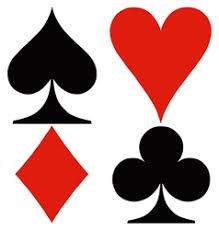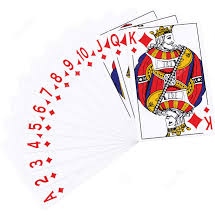Science > Mathematics > Statistics and Probability > Probability > Problems Based on Drawing 2 Playing Cards
In the last few articles, we have seen to solve problems based on tossing of coins, throwing dice, and selecting numbered cards. In this article, we shall study the problems to find the probability involving the draw of two playing cards. For e.g. Two cards are drawn from a well-shuffled pack of 52 playing cards. Find the probability of getting both red cards

Problems based on the Draw of 2 Playing Cards:
Example – 01:
Two cards are drawn from a well-shuffled pack of 52 playing cards. Find the probability of getting
Solution:
There are 52 cards in a pack.
two cards out of 52 can be drawn by 52C2 ways
Hence n(S) = 52C2 = 26 x 51
a) both club cards
Let A be the event of getting both club cards
There are 13 club cards in a pack
two club cards out of 13 club cards can be drawn by 13C2 ways
∴ n(A) = 13C2 = 13 x 6
By the definition P(A) = n(A)/n(S) = (13 x 6)/(26 x 51) = 1/17
Therefore the probability of getting both club cards is 1/17
b) both red cards
Let B be the event of getting both red cards
There are 26 red cards in a pack
two red cards out of 26 red cards can be drawn by 26C2 ways
∴ n(B) = 26C2 = 13 x 25
By the definition P(B) = n(B)/n(S) = (13 x 25)/(26 x 51) = 25/102
Therefore the probability of getting both red cards is 25/102
c) both black cards
Let C be the event of getting both black cards
There are 26 black cards in a pack
two black cards out of 26 black cards can be drawn by 26C2 ways
∴ n(C) = 26C2 = 13 x 25
By the definition P(C) = n(C)/n(S) = (13 x 25)/(26 x 51) = 25/102
Therefore the probability of getting both black cards is 25/102
d) both kings
Let D be the event of getting both kings
There are 4 kings in a pack
two kings out of four kings can be drawn by 4C2 ways
∴ n(D) = 4C2 = 2 x 3
By the definition P(D) = n(D)/n(S) = (2 x 3)/(26 x 51) = 1/221
Therefore the probability of getting both kings is 1/221
Note: The probability of getting two cards of a particular denomination is always 1/221
e) both red aces
Let E be the event of getting both red aces
There are 2 red aces in a pack
two red aces out of two red aces can be drawn by 2C2 ways
∴ n(E) = 2C2 = 1
By the definition P(E) = n(E)/n(S) = (1)/(26 x 51) = 1/1326
Therefore the probability of getting both red aces is 1/1326
f) both face cards
Let F be the event of getting both face cards
There are 12 face cards in a pack
two face cards out of 12 face cards can be drawn by 12C2 ways
∴ n(F) = 12C2 = 6 x 11
By the definition P(F) = n(F)/n(S) = (6 x 11)/(26 x 51) = 11/221
Therefore the probability of getting both red aces is 1/1326
g) cards of denomination between 4 and 10
Let G be the event of getting cards of denomination between 4 and 10
Denominations between 4 and 10 are 5, 6, 7, 8, 9 (total 5 denominations)
Each denomination has 4 cards
Thus there are 5 x 4 = 20 cards of denomination between 4 and 10
two such cards out of 20 can be drawn by 20C2 ways
∴ n(G) = 20C2 = 10 x 19
By the definition P(G) = n(G)/n(S) = (10 x 19)/(26 x 51) = 95/663
Therefore the probability of getting cards of denomination between 4 and 10 is 95/663
h) both red face cards
Let H be the event of getting both red face cards
There are 6 red face cards in a pack
two red face cards out of 6 red face cards can be drawn by 6C2 ways
∴ n(H) = 6C2 = 3 x 5
By the definition P(H) = n(H)/n(S) = (3 x 5)/(26 x 51) = 5/442
Therefore the probability of getting both red face cards is 5/442.
i) a queen and a king
Let J be the event of getting a queen and a king
There 4 kings and 4 queens in a pack
one king out of 4 can be selected by 4C1 ways and
one queen out of 4 can be selected by 4C1 ways
∴ n(J) = 4C1 x 4C1 = 4 x 4 = 16
By the definition P(J) = n(J)/n(S) = 16/(26 x 51) = 6/663
Therefore the probability of getting a queen and a king is 6/663
j) one spade card and another non-spade card.
Let K be the event of getting one spade card and another non-spade card.
There 13 spade cards and 39 non-spade cards in a pack
one spade card out of 13 spade cards can be selected by 13C1 ways and
one non-spade card out of 39 non-spade cards can be selected by 39C1 ways
∴ n(K) = 13C1 x 39C1 = 13 x 39
By the definition P(K) = n(K)/n(S) = (13 x 39)/(26 x 51) = 13/34
Therefore the probability of getting one spade card and another non-spade card is 13/34
l) both cards from the same suite
Let L be the event of getting both cards from the same suite
There 13 cards in each suite
two cards out of 13 cards of the same suite can be selected by 13C2 ways
There are four suites in a pack
Event M = both are spade cards or both are club cards or both are diamond cards or both are heart cards
∴ n(M) = 13C2 + 13C2 + 13C2 + 13C2 = 4 x 13C2 = 4 x 13 x 6
By the definition P(M) = n(M)/n(S) = (4 x 13 x 6)/(26 x 51) = 4/17
Therefore the probability of getting both cards of the same suite is 4/17
m) both are of the same denomination
Let N be the event of getting both cards of the same denomination
There 4 cards of the same denomination
two cards out of 4 cards of the same denomination can be selected by 4C2 ways
There are 13 sets of the same denomination
∴ n(N) = 13 x 4C2 = 13 x 2 x 3
By the definition P(N) = n(N)/n(S) = (13 x 2 x 3)/(26 x 51) = 1/17
Therefore the probability of getting both cards of the same denomination is 1/17
o) One is spade and other is ace
Let Q be the event of getting one spade and another ace
There are two possibilities
Case – 1: When the first card is spade with spade ace included and another is ace from remaining three aces
Case – 2: When the first card is spade with ace excluded and another is ace from four aces
∴ n(Q) = 13C1 x 3C1 + 12C1 x 4C1 = 13 x 3 + 12 x 4 = 39 + 48 = 87
By the definition P(N) = n(N)/n(S) = 87/(26 x 51) = 29/442
Therefore the probability of getting one spade and other ace is 29/442
In the next article, we shall study some basic problems of probability based on the drawing of three cards from a pack of playing cards.
